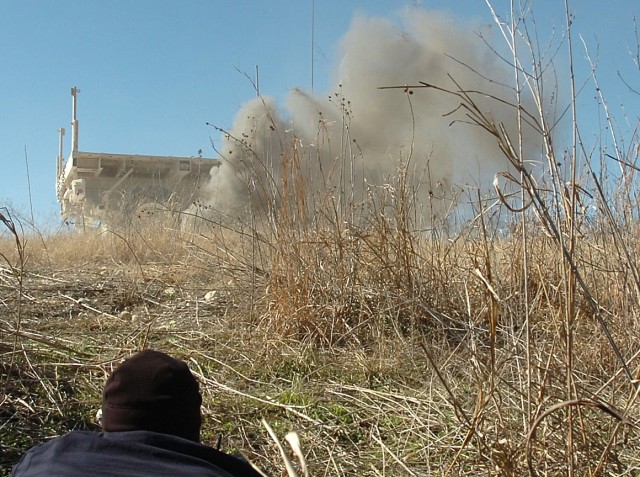WHITE SANDS MISSILE RANGE, N.M. (Army News Service, March 10, 2008) - Science fiction is becoming reality at the Joint Directed Energy Test Site at White Sands Missile Range.
The site, currently undergoing an expansion and enhancement, is being used to test and evaluate new directed energy weapons designed to detect and destroy Improvised Explosive Devices like the ones being used in Iraq and Afghanistan. Systems being tested use different types of directed energy, including microwaves, lasers, and even bolts of electricity, to disable or destroy IEDs before the vehicle they are mounted on get too close.
Since counter IED systems are of such critical importance to protecting servicemembers in the field, the JDETS mission is a very high priority one at WSMR and in the Army. "I've briefed the Developmental Test Command commander and the U.S. Army Test and Evaluation Command commander, (they) said that this is our number-one priority and they want us to press it and push it as hard as we can," said Brad King, project director for JDETS development, with the System Engineering Development Directorate.
Many counter IED systems use an omni-directional system that can affect other electrical systems in the area.
"The idea (behind those systems) is to provide a bubble of protection around either a civilian or military convoy," King said. By switching to directed-energy weapons, Service members in the field can disable or destroy IEDs without disrupting nearby systems, services or utilities.
The JDETS timetable for programs is very rapid, with systems being tested and evaluated so that they can be ready for deployment as soon as possible, officials said. Some systems need to have their testing complete in as few as 30 days.
"(Higher headquarters) want us to execute as quickly as we can, for obvious reasons. Every one of these systems that we test that gets out in theater will hopefully counter these devices," King said.
Speed is not just important in getting new systems to the troops in the field, but also in keeping up with new weapons and tactics insurgents might be developing.
"It's a dynamic environment; the insurgents are pretty innovative about the things they are trying to do to kill people or to make (IEDs) more effective," King said.
Even though IEDs have appeared in Iraq and Afghanistan, King believes the systems being tested at JDETS will continue to see use in future theaters of operation.
"Unfortunately we think this is going to be a growth industry, we think there are IEDs being put in place in a lot of places," King said. But the future of JDETS isn't just in the defeat of IEDs in Iraq and Afghanistan, but to look to the future of ambush weapons. "Part of our mission from DTC says we are supposed to look at future and emerging technologies, and some of those include airborne mechanisms as well," King said.
To further enhance the capabilities of the test site, JDETS is expanding. Future plans include the construction of roads with sharp turns, a small section with buildings that can simulate an urban environment, enhanced observation and monitoring equipment, and even a small freeway overpass. "We're trying to emulate some of the conditions and some of the structures that might be seen in theater," King said.
In addition to counter IED work, the site enhancement is also seeing interest from other programs to test their systems at the site.
"Some (Air Force programs) are interested in doing testing in an environment where the structures accurately represent what's in Iraq and Afghanistan. So while that's not the primary purpose why we're building it, (the site) has applications in those areas," King said.
Directed energy testing isn't a one-man show though, it takes many different people and organizations to make it all happen.
"The Material Test Directorate: Robert Reynolds, Jim Eubanks, Eduardo Contreras; the System Vulnerability Assessment Directorate: Edwin Dunlap, Russ Blundell, Stephanie Jesson; the System Engineering Development Directorate: Hector Gurrola, Jose Gonzalez; the Directorate of Public Works: Sam Morris, Sam Sanchez; Range Operations: Anthony Blea, Ray Lozano and many others across WSMR have been key to the support of JDETS testing. Truly lots of folks across several major directorates at WSMR have worked hard to make this program a success," King said.


Social Sharing